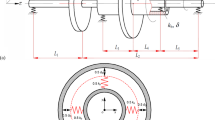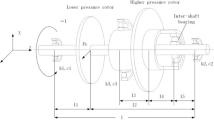Abstract
Background
This paper proposes an analytical method to study the nonlinear phenomena of a simple dual-rotor system in the case of primary resonances.
Purpose
According to the assumed mode method (AMM), the dynamic equations of the system with four degrees of freedom (4DOF) are established by considering the nonlinearities of the inter-shaft bearing as a nonlinear spring. The 4DOF dynamic equations in real coordinate are transferred into 2DOF dynamic equations in complex coordinate because of the symmetry of the system in two directions.
Methods
Then the amplitude-frequency response equations for both primary resonances are obtained by the multiple scales method and the numerical verification shows that the simplified method of the dynamic equation is correct. Moreover, the primary resonances affected by the typical parameters such as the linear stiffness and the nonlinear stiffness of the inter-shaft bearing, and the rotation speed ratio are discussed in detail afterwards.
Conclusions
The results show that the system will show the jump phenomenon and resonance hysteresis phenomenon when the linear stiffness is rather small and the nonlinear stiffness is rather large. The linear stiffness will suppress these nonlinear phenomena while the nonlinear stiffness will promote them. The results obtained in this paper will contribute to the mechanism analysis of the nonlinear phenomena in a dual-rotor system, which is beyond the reach of the numerical method.








Similar content being viewed by others
References
Guskov M, Sinou JJ, Thouverez F et al (2007) Experimental and numerical investigation of a dual-shaft test rig with intershaft bearing. Int J Rotat Mach. https://doi.org/10.1155/2007/75762
Li QH, Hamilton JF (1985) Investigation of the transient response of a dual-rotor system with intershaft squeeze-film damper. J Eng Gas Turb Power 108:613–618
López-Reyes LJ, Kurmyshev EV (2018) Parametric resonance in nonlinear vibrations of string under harmonic heating. Commun Nonlinear Sci 55:146–156
Chedjou JC, Fotsin HB, Woafo P et al (2001) Analog simulation of the dynamics of a van der Pol oscillator coupled to a Duffing oscillator. IEEE Trans Circ Syst I Fund Theory Appl 48:748–757
Hibner DH (1975) Dynamic response of viscous-damped multi-shaft jet engines. J Aircraft 12:305–312
Gupta K, Gupta KD, Athre K (1993) Unbalance response of a dual rotor system: theory and experiment. J Vib Acoust 115:427–435
Gao P, Hou L, Yang R et al (2019) Local defect modelling and nonlinear dynamic analysis for the inter-shaft bearing in a dual-rotor system. Appl Math Model 68:29–47
Nelson HD, McVaugh JM (1976) The dynamics of rotor-bearing systems using finite elements. Trans Am Soc Mech Engineers J Eng Industry 98:593–600
Yang Y, Cao DQ, Yu TH et al (2016) Prediction of dynamic characteristics of a dual-rotor system with fixed point rubbing—Theoretical analysis and experimental study. Int J Mech Sci 115–116:253–261
Wang NF, Jiang DX, Behdinan K (2017) Vibration response analysis of rubbing faults on a dual-rotor bearing system. Arch Appl Mech 87:1891–1907
Wang NF, Liu C, Jiang DX et al (2019) Casing vibration response prediction of dual-rotor-blade-casing system with blade-casing rubbing. Mech Syst Signal Pr 118:61–77
Lu ZY, Hou L, Chen YS et al (2016) Nonlinear response analysis for a dual-rotor system with a breathing transverse crack in the hollow shaft. Nonlinear Dyn 83:169–185
Ferraris G, Maisonneuve V, Lalanne M (1996) Prediction of the dynamic behavior of non-symmetric coaxial co- or counter-rotating rotors. J Sound Vib 154:649–666
Sun CZ, Chen YS, Hou L (2016) Steady-state response characteristics of a dual-rotor system induced by rub-impact. Nonlinear Dyn 86:91–105
Sun CZ, Chen YS, Hou L (2018) Nonlinear dynamical behaviors of a complicated dual-rotor aero-engine with rub-impact. Arch Appl Mech 88:1305–1324
Lu ZY, Chen YS, Li HL et al (2016) Reversible model-simplifying method for aero-engine rotor systems. J Aerosp Power 31:57–64
Perepelkin NV, Mikhlin YV, Pierre C (2013) Non-linear normal forced vibration modes in systems with internal resonance. Int J Nonlin Mech 57:102–115
Jin YL, Lu ZY, Yang R et al (2018) A new nonlinear force model to replace the Hertzian contact model in a rigid-rotor ball bearing system. Appl Math Mech-Engl 39:365–378
Hou L, Chen YS, Fu YQ et al (2017) Application of the HB-AFT method to the primary resonance analysis of a dual-rotor system. Nonlinear Dyn 88:2531–2551
Chen HZ (2017) Study on nonlinear dynamics of squeeze film damper-rolling bearing-rotor systems. Harbin Institute of Technology, Harbin, pp 90–95
Chen HZ, Hou L, Chen YS (2017) Bifurcation analysis of a rigid-rotor squeeze film damper system with unsymmetrical stiffness supports. Arch Appl Mech 87:1347–1364
Kim YB, Noah ST (1996) Quasi-periodic response and stability analysis for a non-linear Jeffcott rotor. J Sound Vib 190:239–253
Acknowledgements
It is very grateful for the financial supports from the National Science and Technology Major Project of China (No. 2017-IV-0008-0045) and the National Natural Science Foundation of China (nos. 11972129 and 11602070).
Author information
Authors and Affiliations
Corresponding author
Ethics declarations
Conflict of interest
The authors declare that they have no conflict of interest.
Additional information
Publisher's Note
Springer Nature remains neutral with regard to jurisdictional claims in published maps and institutional affiliations.
Appendix
Appendix
The nonlinear contact force of the inter-shaft bearing in the complex coordinate is
where the term \(\left\{ {\left( {X_{\text{i}} - X_{\text{o}} } \right)\left[ {\left( {X_{\text{i}} - X_{\text{o}} } \right)^{2} - 3\left( {Y_{\text{i}} - Y_{\text{o}} } \right)^{2} } \right] + i\left( {Y_{\text{i}} - Y_{\text{o}} } \right)\left[ {\left( {Y_{\text{i}} - Y_{\text{o}} } \right)^{2} - 3\left( {X_{\text{i}} - X_{\text{o}} } \right)^{2} } \right]} \right\}\) is calculated as
Therefore, the nonlinear contact force in the complex coordinate can be expressed as
Rights and permissions
About this article
Cite this article
Gao, P., Hou, L. & Chen, Y. Analytical Analysis for the Nonlinear Phenomena of a Dual-Rotor System at the Case of Primary Resonances. J. Vib. Eng. Technol. 9, 529–540 (2021). https://doi.org/10.1007/s42417-020-00245-y
Received:
Revised:
Accepted:
Published:
Issue Date:
DOI: https://doi.org/10.1007/s42417-020-00245-y




